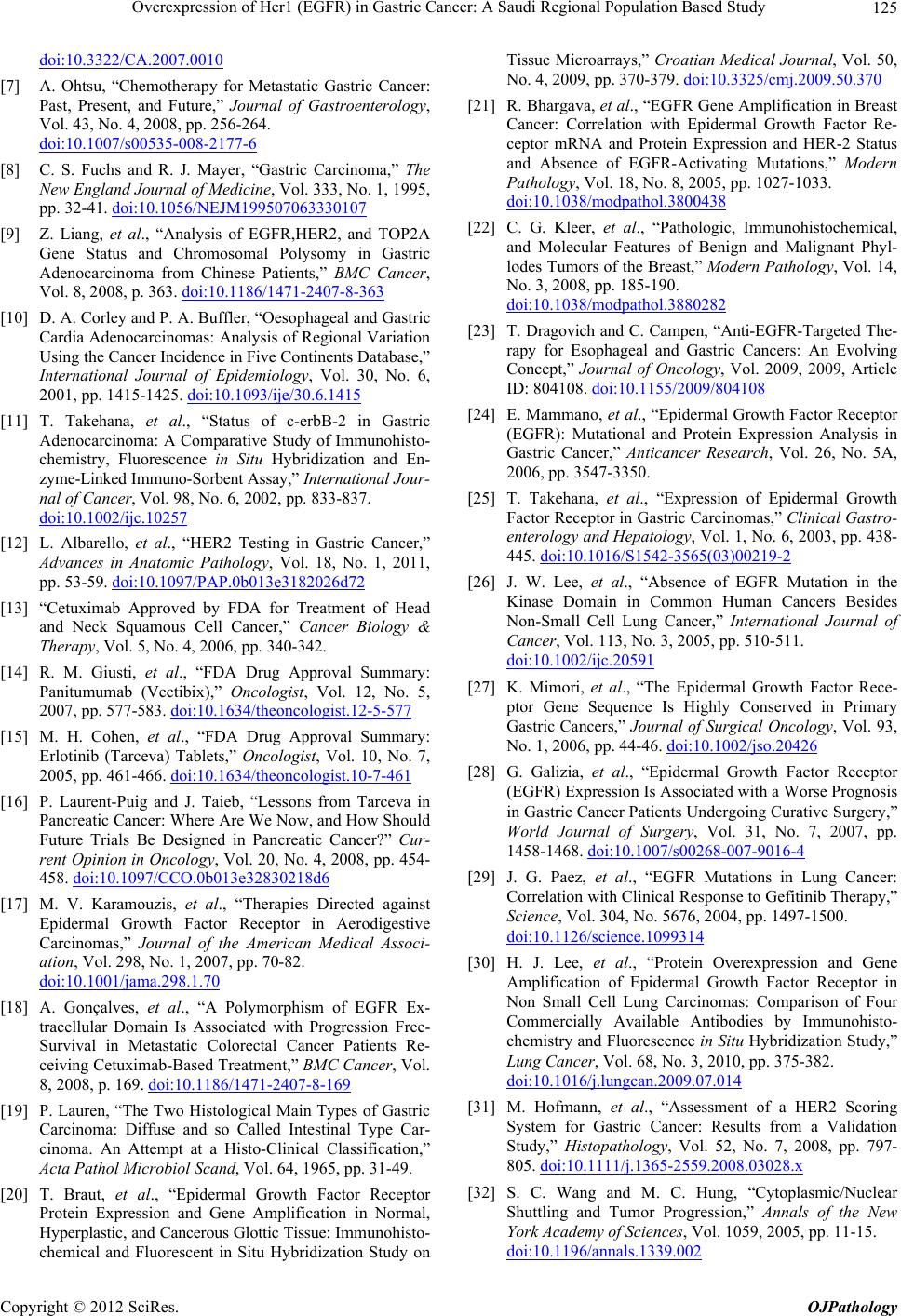
Overexpression of Her1 (EGFR) in Gastric Cancer: A Saudi Regional Population Based Study 125
doi:10.3322/CA.2007.0010
[7] A. Ohtsu, “Chemotherapy for Metastatic Gastric Cancer:
Past, Present, and Future,” Journal of Gastroenterology,
Vol. 43, No. 4, 2008, pp. 256-264.
doi:10.1007/s00535-008-2177-6
[8] C. S. Fuchs and R. J. Mayer, “Gastric Carcinoma,” The
New England Journal of Medicine, Vol. 333, No. 1, 1995,
pp. 32-41. doi:10.1056/NEJM199507063330107
[9] Z. Liang, et al., “Analysis of EGFR,HER2, and TOP2A
Gene Status and Chromosomal Polysomy in Gastric
Adenocarcinoma from Chinese Patients,” BMC Cancer,
Vol. 8, 2008, p. 363. doi:10.1186/1471-2407-8-363
[10] D. A. Corley and P. A. Buffler, “Oesophageal and Gastric
Cardia Adenocarcinomas: Analysis of Regional Variation
Using the Cancer Incidence in Five Continents Database,”
International Journal of Epidemiology, Vol. 30, No. 6,
2001, pp. 1415-1425. doi:10.1093/ije/30.6.1415
[11] T. Takehana, et al., “Status of c-erbB-2 in Gastric
Adenocarcinoma: A Comparative Study of Immunohisto-
chemistry, Fluorescence in Situ Hybridization and En-
zyme-Linked Immu no-Sorbent Assay ,” International J ou r-
nal of Cancer, Vol. 98, No. 6, 2002, pp. 833-837.
doi:10.1002/ijc.10257
[12] L. Albarello, et al., “HER2 Testing in Gastric Cancer,”
Advances in Anatomic Pathology, Vol. 18, No. 1, 2011,
pp. 53-59. doi:10.1097/PAP.0b013e3182026d72
[13] “Cetuximab Approved by FDA for Treatment of Head
and Neck Squamous Cell Cancer,” Cancer Biology &
Therapy, Vol. 5, No. 4, 2006, pp. 340-342.
[14] R. M. Giusti, et al., “FDA Drug Approval Summary:
Panitumumab (Vectibix),” Oncologist, Vol. 12, No. 5,
2007, pp. 577-583. doi:10.1634/theoncologist.12-5-577
[15] M. H. Cohen, et al., “FDA Drug Approval Summary:
Erlotinib (Tarceva) Tablets,” Oncologist, Vol. 10, No. 7,
2005, pp. 461-466. doi:10.1634/theoncologist.10-7-461
[16] P. Laurent-Puig and J. Taieb, “Lessons from Tarceva in
Pancreatic Cancer: Where Are We Now, and How Should
Future Trials Be Designed in Pancreatic Cancer?” Cur-
rent Opinion in Oncology, Vol. 20, No. 4, 2008, pp. 454-
458. doi:10.1097/CCO.0b013e32830218d6
[17] M. V. Karamouzis, et al., “Therapies Directed against
Epidermal Growth Factor Receptor in Aerodigestive
Carcinomas,” Journal of the American Medical Associ-
ation, Vol. 298, No. 1, 2007, pp. 70-82.
doi:10.1001/jama.298.1.70
[18] A. Gonçalves, et al., “A Polymorphism of EGFR Ex-
tracellular Domain Is Associated with Progression Free-
Survival in Metastatic Colorectal Cancer Patients Re-
ceiving Cetuximab-Based Treatment,” BMC Cancer, Vol.
8, 2008, p. 169. doi:10.1186/1471-2407-8-169
[19] P. Lauren, “The Two Histological Main Types of Gastric
Carcinoma: Diffuse and so Called Intestinal Type Car-
cinoma. An Attempt at a Histo-Clinical Classification,”
Acta Pathol Microbiol Scand, Vol. 64, 1965, pp. 31-49.
[20] T. Braut, et al., “Epidermal Growth Factor Receptor
Protein Expression and Gene Amplification in Normal,
Hyperplastic, and Cancerous Glottic Tissue: I mm unohisto-
chemical and Fluorescent in Situ Hybridization Study on
Tissue Microarrays,” Croatian Medical Journal, Vol. 50,
No. 4, 2009, pp. 370-379. doi:10.3325/cmj.2009.50.370
[21] R. Bhargava, et al., “EGFR Gene Amplification in Breast
Cancer: Correlation with Epidermal Growth Factor Re-
ceptor mRNA and Protein Expression and HER-2 Status
and Absence of EGFR-Activating Mutations,” Modern
Pathology, Vol. 18, No. 8, 2005, pp. 1027-1033.
doi:10.1038/modpathol.3800438
[22] C. G. Kleer, et al., “Pathologic, Immunohistochemical,
and Molecular Features of Benign and Malignant Phyl-
lodes Tumors of the Breast,” Modern Pathology, Vol. 14,
No. 3, 2008, pp. 185-190.
doi:10.1038/modpathol.3880282
[23] T. Dragovich and C. Campen, “Anti-EGFR-Targeted The-
rapy for Esophageal and Gastric Cancers: An Evolving
Concept,” Journal of Oncology, Vol. 2009, 2009, Article
ID: 804108. doi:10.1155/2009/804108
[24] E. Mammano, et al., “Epidermal Growth Factor Receptor
(EGFR): Mutational and Protein Expression Analysis in
Gastric Cancer,” Anticancer Research, Vol. 26, No. 5A,
2006, pp. 3547-3350.
[25] T. Takehana, et al., “Expression of Epidermal Growth
Factor Receptor in Gastric Carcinomas,” Clinical Gastro-
enterology and Hepatology, Vol. 1, No. 6, 2003, pp. 438-
445. doi:10.1016/S1542-3565(03)00219-2
[26] J. W. Lee, et al., “Absence of EGFR Mutation in the
Kinase Domain in Common Human Cancers Besides
Non-Small Cell Lung Cancer,” International Journal of
Cancer, Vol. 113, No. 3, 2005, pp. 510-511.
doi:10.1002/ijc.20591
[27] K. Mimori, et al., “The Epidermal Growth Factor Rece-
ptor Gene Sequence Is Highly Conserved in Primary
Gastric Cancers,” Journal of Surgical Oncology, Vol. 93,
No. 1, 2006, pp. 44-46. doi:10.1002/jso.20426
[28] G. Galizia, et al., “Epidermal Growth Factor Receptor
(EGFR) Expression Is Associated with a Worse Prognosis
in Gastric Cancer Patients Undergoing Curative Surgery,”
World Journal of Surgery, Vol. 31, No. 7, 2007, pp.
1458-1468. doi:10.1007/s00268-007-9016-4
[29] J. G. Paez, et al., “EGFR Mutations in Lung Cancer:
Correlation with Clinical Response to Gefitinib Therapy,”
Science, Vol. 304, No. 5676, 2004, pp. 1497-1500.
doi:10.1126/science.1099314
[30] H. J. Lee, et al., “Protein Overexpression and Gene
Amplification of Epidermal Growth Factor Receptor in
Non Small Cell Lung Carcinomas: Comparison of Four
Commercially Available Antibodies by Immunohisto-
chemistry and Fluorescence in Situ Hybridization Study,”
Lung Cancer, Vol. 68, No. 3, 2010, pp. 375-382.
doi:10.1016/j.lungcan.2009.07.014
[31] M. Hofmann, et al., “Assessment of a HER2 Scoring
System for Gastric Cancer: Results from a Validation
Study,” Histopathology, Vol. 52, No. 7, 2008, pp. 797-
805. doi:10.1111/j.1365-2559.2008.03028.x
[32] S. C. Wang and M. C. Hung, “Cytoplasmic/Nuclear
Shuttling and Tumor Progression,” Annals of the New
York Academy of Sciences, Vol. 1059, 2005, pp. 11-15.
doi:10.1196/annals.1339.002
Copyright © 2012 SciRes. OJPathology